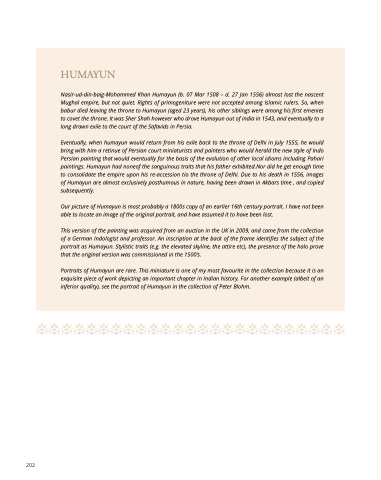Page 208 - Eye of the beholder
P. 208
huMayun
Nasir-ud-din-baig-Mohammed Khan Humayun (b 07 Mar 1508 – d d d d 27 Jan 1556) almost lost the nascent Mughal empire but not not quiet Rights of primogeniture were not not accepted among Islamic rulers So when babur died leaving the the throne to Humayun (aged 23 years) his his other siblings were among his his first emenies to to covet the throne It was Sher Shah however who drove Humayun out of india in in 1543 and eventually to to a a a a a a a long drawn exile to the the court of the the Safavids in Persia Eventually when humayun would would return from his exile back to the throne of Delhi in July 1555 he he he would would bring with him a a a a a a retinue of of Persian court miniaturists and painters who would herald the new style of of Indo Persian painting that would eventually for the the the basis of of the the the evolution of of other local idioms including Pahari paintings Humayun had noneof the the sanguinous traits that his father exhibited Nor did he he he get enough time to to consolidate the the empire upon his his re-accession tio the the throne of Delhi Due to to his his death in 1556 images of Humayun are almost exclusively posthumous in in in nature having been drawn in in in Akbars time and copied subsequently Our picture of of Humayun is most probably a a a a a a a 1800s copy of of an earlier 16th century portrait I have not been able to to locate an an image of the original portrait and have have assumed it it to to have have been lost This version of the the the painting was acquired from from an an auction in in in in the the the UK in in in in 2009 and came from from the the the collection of of of of a a a a a a German Indologist and professor An inscription at the the the the back of of of of the the the the frame identifies the the the the subject of of of of the the the the portrait as Humayun Stylistic traits (e g the the the the elevated skyline the the the the attire etc) the the the the presence of the the the the halo prove that the the original version was commissioned in in the the 1500’s Portraits of of Humayun are are rare This miniature is is is one of of my most favourite in in the collection because it it it is is is an exquisite piece of of work depicting an an an an an important chapter in in Indian history For another example (albeit of of an an an an an inferior quality) see the the portrait of of Humayun in in the the collection of of Peter Blohm 202


